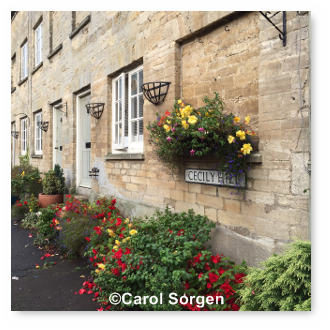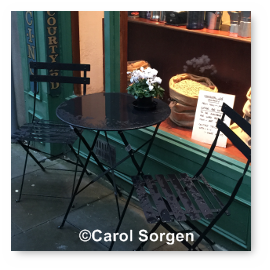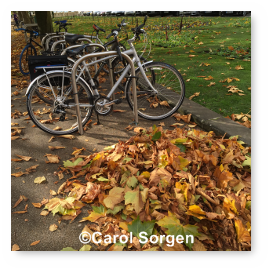Three (Well, Maybe 3½) Days in the Cotswolds
JustSayGo.com
You could spend a week, a month, or even longer in the Cotswolds, that magical piece of England that devotees of such British shows as “Midsomer Murders” are so enamored of. (Downton fans—Highclere Castle is not technically in the Cotswolds, but it’s not far, so don’t think it’s an either-or proposition; it just may be closed when you’re there, as it was for us!) But even if you only have several days, you can make a pretty good dent in the region, as I found out on a recent trip. Follow my itinerary or strike off on your own. You can't go wrong no matter where you go!
Day 1 The Cotswolds, known for the many honey-colored limestone cottages dotting its postcard-worthy villages, is best explored by car (though with some planning, you could get by with public transportation, but it will leave you less able to wander and discover on your own). As London traffic can be daunting however-to put it mildly!-my friend and frequent traveling companion, Nan, and I decided to take a train from the city and rent a car at our first destination. A word of advice: Plan well ahead (preferably before you leave home) if you're going to rent a car in the Cotswolds. We tried to do it from our hotel in London, but there were no cars to be had at that time (thank you to Duncan, though, concierge extraordinare at the equally delightful hotel, The Athenaeum, www.athenaeumhotel.com, for trying to make this wizardry happen).
The Cotswolds, known for the many honey-colored limestone cottages dotting its postcard-worthy villages, is best explored by car (though with some planning, you could get by with public transportation, but it will leave you less able to wander and discover on your own). As London traffic can be daunting however-to put it mildly!-my friend and frequent traveling companion, Nan, and I decided to take a train from the city and rent a car at our first destination. A word of advice: Plan well ahead (preferably before you leave home) if you're going to rent a car in the Cotswolds. We tried to do it from our hotel in London, but there were no cars to be had at that time (thank you to Duncan, though, concierge extraordinare at the equally delightful hotel, The Athenaeum, www.athenaeumhotel.com, for trying to make this wizardry happen).
Deciding to work things out as we went along, we headed to Paddington Station (yes, plenty of Paddington Bears around) to the itty-bitty Cotswolds village of Kemble where we ran into our next snag. No taxis! A signboard outside the station listed local taxi firms but, unfortunately, there wasn't one available for quite some time. On the off chance that a rental car had turned up, we called the local Enterprise office which had, fortunately, just had a return. In short order, the car was delivered to us, we filled out the paperwork, and were soon on our way, unfortunately,though, sans GPS. Another word of advice: Rental cars do not appear to be equipped with a GPS, nor was any available to rent. Using your US-based mobile phone as a GPS will cost a pretty pound or two in data downloads, so if you have a standalone GPS at home that you can bring with you, consider that...or reserve a car and GPS before you even leave your home base.
Once the logistical issues were out of the way, it was time for our Cotswolds adventure to begin. Our first night's stop was in Cirencester at the recently restored Kings Head Hotel (www.kingshead-hotel.co.uk), a stylish, elegant, but not at all pretentious 45-room boutique hotel. Located right in the center of town, it was an ideal location for exploring this lively market town which still has a twice-weekly street market, along with a number of smaller farmers markets, antiques markets, and the like.
Cirencester had its beginnings in the Roman period when it was known as Corinium Dobunnorum and was one of the regional capitals of Roman Britain. Whether or not you're an ancient history buff (and I confess that I'm not), the award-winning, interactive Corinium Museum (www.coriniummuseum.org) is well worth a visit for a look at how Cirencester has evolved through the centuries.
Dominating the town center and serving as your point of reference is the parish church of St. John Baptist, known as "Cathedral of the Cotswolds" and a symbol of the wealth and influence Cirencester had as a thriving wool town in medieval England.
Cirencester is also a popular arts and crafts center, with numerous craft fairs held throughout the year. We especially enjoyed the New Brewery Arts Centre (www.newbreweryarts.org.uk) which includes exhibition space, classes, special events, and a craft shop well-stocked with British handmade crafts.
Day 2
The sun was shining the next morning--as it had not been the day before!--so we took the opportunity before setting off for an early morning walk in the 19th-century landscaped Cirencester Park, which has been owned by the same family (the Bathhursts) for more than three centuries. A local resident stopped us to point out the 300-year-old, 40-foot yew hedge that sits alongside Lord Bathurst's estate and can be seen from all over town. Clippings from the hedge, which takes a week to tidy up and costs its owner 6,000 GBP a year to maintain, are sold to pharmaceutical companies which use yew extract as a principal ingredient of Docetaxel, a chemotherapy drug used for breast, ovarian, and lung cancer.
After sufficiently stretching our legs, we sadly left Cirencester (unfortunately, no time for dilly-dallying) for our next brief stop, Tetbury, whose Market House in the center of town was built in 1655 for the sale of wool and yarn. Tetbury itself dates back to the 7th century and, according to local guides, probably into prehistory as a defended hilltop site. Today, Tetbury's streets are lined with historic buildings, many of which house a wide variety of art galleries and antiques shops. (The days of picking up an English antique for a song, however, are long gone!) More reasonable souvenirs can be found at The Highgrove Shop, which sells exclusive gifts for the home and garden that often reflect the personal interests of HRH The Prince of Wales, whose estate is nearby. It was a good place to stock up on gifts...though I'm still regretting passing on the cashmere socks! (Highgrove House and Westonbirt Arboretum are both nearby local attractions, but on our whirlwind tour, we had to pass them by this time.)
 After lunch at Cafe 53, a popular local eatery (it's always a good sign when you hear no other American accents!), it was back into the car to drive on to Uley to visit the Prema Arts Centre (http://prema.org.uk). Prema was conceived by sculptor Andrew Wood whose idea was to offer an art space for those on the cutting edge as well as those more established and traditional, providing a creative experience accessible to all. GPS-free we still managed to find it (not without a few missteps along the way!) but bad news! The exhibition space was closed for the season. It came highly recommended though, so though I can't vouch for it myself, if you happen to be nearby, it may well be worth a trip...just check their website, or better yet, call first.
After lunch at Cafe 53, a popular local eatery (it's always a good sign when you hear no other American accents!), it was back into the car to drive on to Uley to visit the Prema Arts Centre (http://prema.org.uk). Prema was conceived by sculptor Andrew Wood whose idea was to offer an art space for those on the cutting edge as well as those more established and traditional, providing a creative experience accessible to all. GPS-free we still managed to find it (not without a few missteps along the way!) but bad news! The exhibition space was closed for the season. It came highly recommended though, so though I can't vouch for it myself, if you happen to be nearby, it may well be worth a trip...just check their website, or better yet, call first.
As we were visiting in late October, just after the clocks turned back and it starts to get dark early, we decided it was best to head to our next overnight destination, Cheltenham. Cheltenham's not the size of London, of course, but it's bigger than anything we had seen so far, which is my subtle way of saying, if you're on a schedule, leave yourself enough time to deal with rush hour and/or finding where you need to be!
We apologize to the very nice young woman who stayed past her leaving time and remained on the phone with us, guiding our way to The Montpellier Chapter Hotel (www.themontpellierchapterhotel.com), a restored Victorian villa, now with a decidedly contemporary vibe. Since it was raining, we decided to just stay put for the evening, starting out with wine and cheese in the library and moving into the hotel restaurant, which, like that of The Kings Head in Cirencester, appears to be a popular spot for locals.
Day 3
T he sun had returned in the morning so we walked into town and strolled down the Promenade with its many stylish boutiques, and through the open air market. Cheltenham is known as a spa town and visitors have been coming there for nearly 300 years, since the first natural springs were discovered in 1716. It is also host to numerous international festivals and events, beautiful parks and gardens, impressive Regency architecture, and the Cheltenham Gold Cup, which is the beginning of the town's well-known racing season.
he sun had returned in the morning so we walked into town and strolled down the Promenade with its many stylish boutiques, and through the open air market. Cheltenham is known as a spa town and visitors have been coming there for nearly 300 years, since the first natural springs were discovered in 1716. It is also host to numerous international festivals and events, beautiful parks and gardens, impressive Regency architecture, and the Cheltenham Gold Cup, which is the beginning of the town's well-known racing season.
After a morning exploring Cheltenham, it was back into the car for the drive to Stow on the Woldand a quick walk around the pretty--but crowded, that day (half-term crowds!)--village. After a bite to eat at Huffkins, a family-owned Cotswolds bakery and tea room that dates back to the late 19th century, and our first taste of a Lardy cake (sweet dough with currants, brown sugar, and butter--lard has fortunately been retired!), it was off to Bourton on the Water, a particularly scenic (and also crowded!) village. Many of the cottages and houses are at least 300 years old, some even going back as far as Elizabethan times, and with the River Windrush running straight through it, crossed at regular intervals with small stone bridges, Bourton on the Water has earned its nickname, "The Venice of the Cotswolds."
There is much to see and do here (though on a sunny late autumn afternoon, ice cream eating seemed be high on many of the visitors' list). If you want to do more than just stroll and snap your smartphone's camera to your heart's content, you can visit The Cotswolds Perfumery, Birdland, The Miniature Village, Motoring Museum & Toy Museum, and the Model Railway
As the sun was starting to sink again, we were back on the road to find our next overnight destination, Burford, known locally as the Gateway to the Cotswolds. We checked into the Inn for All Seasons (www.innforallseasons.com), parts of which date back to the 1500s as quarry cottages. It was turned into a coaching inn in the 1700s, accommodating travelers on what would have been the main route from London. The Inn now offers not only rooms and dining but a cookery school as well. Our accommodations were clean but very basic (I can't speak about the other rooms, but ours looked nothing like the photos on the website), but the food in the restaurant was inventive and delicious.
Day 4
OK, I did say three days in the Cotswolds, but given weather, traffic, and early days because of the time change, it was more like 3-1/2. After a filling breakfast at the Inn, we drove into Burford’s town center. Since not much was open yet, we took a walk,  camera phones in hand, around this exceedingly pretty spot whose industrial beginnings were based on wool, stone, brewing bell-founding, and saddle- and bridle-making.
camera phones in hand, around this exceedingly pretty spot whose industrial beginnings were based on wool, stone, brewing bell-founding, and saddle- and bridle-making.
If you're an architecture buff, you'll appreciate the collection of 14th- and 16th-century houses. And if you're an artist, whether one with aspirations or one with much experience, check out the exhibition and class schedule of the James Fletcher-Watson Gallery (www.jamesfletcherwatson.com). Fletcher-Watson, who died in 2004, was one of Britain's leading landscape watercolorists, and established a gallery when he moved to the Cotswolds. According to the owner of the Inn for All Seasons, artists come from all over the world to take classes at the gallery, now run by Fletcher-Watson's daughter.
By mid-morning it was time to leave the Cotswolds, as we were heading back to the States the following day and wanted to make a quick stop at Oxford before our overnight stay in Windsor (the Queen appeared not to be in residence, though there was a spectacular fireworks display for Guy Hawkes Day lighting up the sky that night). There is much we didn't get to do or see in the Cotswolds, but our appetites were certainly whet enough to entice us to return, hopefully for a longer stay. (I’ve always dreamed of renting one of those honey-colored cottages for a month and just settling in!)
Several takeaway pieces of advice from our whirlwind visit: Try to go before the clocks change back (that really cut out several hours of sightseeing a day); on the other hand, also avoid the height of the season in summer as well (though the days will be long, so will the lines to get in anywhere and the road traffic); and finally, check the calendar (the British calendar, that is); we didn't know, for example, that it was half-term for schools throughout England, and for a late October visit, there were many more crowds than we anticipated. In addition, unlike a larger city like London, some attractions in the smaller villages might close for the winter (always best to check ahead first).
That being said, however, for someone whose television is regularly tuned to BBC America or PBS UK, the Cotswolds was everything I always imagined it to be. I think you'll find it so too.
For more information:
www.visitbritain.com
www.cotswolds.com